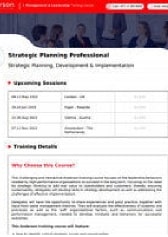
An Intensive 5-day Training Course
Financial Forecasting in a VUCA World
Sales, Valuation and Performance Forecasting Tools
UPCOMING SESSIONS
| Date | Venue | Fee | |
|---|---|---|---|
| 09-13 Feb 2026 | Amsterdam - The Netherlands | $5,950 | RESERVE A SEAT |
| 11-15 May 2026 | London - UK | $5,950 | RESERVE A SEAT |
| 03-07 Aug 2026 | Barcelona - Spain | $5,950 | RESERVE A SEAT |
| 12-16 Oct 2026 | Dubai - UAE | $5,950 | RESERVE A SEAT |
Training Course Overview
In today’s new economy, one of the most daunting realities is the growing atmosphere of volatility, uncertainty, complexity, and ambiguity (VUCA), which significantly complicates financial forecasting. Spreadsheet models have traditionally served as the primary tools for finance professionals to apply their expertise in financial management. Moreover, following the recent financial crisis, there has been a steady rise in demand for skilled Financial Modelling professionals. Organizations increasingly require these professionals to strategize and adapt in response to the challenges posed by the VUCA environment.
This Anderson training course will feature:
- Financial Statement Modelling
- CAPEX
- DCF
- Sensitivity Analysis
- Scenario Analysis
Training Course Objectives
By the end of this training course, participants will be able to:
- Recognise the challenges of VUCA world
- Recognize the purpose of Financial Modelling and Forecasting
- Explain the key steps of Financial Modelling
- Forecast future firm’s performance and Valuation
- Use different planning tools: scenario and sensitivity analysis
Designed for
This Anderson training course is suitable to a wide range of professionals but will greatly benefit:
- Finance Professionals across the organisation
- Head Office Planning Managers
- Budgeting and Forecasting Teams
- Commercial Managers
- Finance Strategic Business Partners
Learning Methods
This training course will utilise a various of proven learning techniques to ensure maximum understanding, comprehension and retention of the information presented. This includes a presentation in a highly interactive manner, individual and group activities interspersed throughout the sessions, along with appropriate case studies and video documentaries that will highlight the significant teaching features.
The Course Outline
- The Imperatives of a VUCA World: a sound of Financial Modelling
- What is Financial Modelling?
- Defining the Inputs and the Outputs of a Simple Financial Model
- The Financial Modelling Process of More Complex Models
- Excel as a Tool of Modelling: Capabilities and Limitations
- How Financial Models Work
- Collecting and Analyzing Historical Data
- Selecting the Key Forecast Drivers
- Modelling the Income Statement
- Modelling the Balance Sheet
- Modelling Interest and Circular References
- Modelling the Cash Flow Statem
- Designing a Dashboard-like Control Panel
- Basic Statistical Methods Used for Forecasting
- Forecasting Sales: Bottom-up Versus Top-down Forecasting
- Forecasting Costs
- Forecasting CAPEX and Depreciation
- Forecasting Funding Needs
- Valuation Approaches
- Steps for Applying the DCF Method
- Rewriting Financial Statements – Calculation of Free Cash Flows
- Calculating the Weighted Average Cost of Capital
- Estimating the Terminal Value
- One-Dimensional and 2-Dimensional Sensitivity Analysis
- Choosing the Variables to Change
- Modelling Example
- Interpreting the Results
- Scenario Analysis Example
The Certificate
- Anderson Certificate of Completion will be provided to delegates who attend and complete the course
In Association With



Learn More About
this course
How can I register for a training course?
There are several convenient ways to register for our training programs:
- Online: Explore our training calendar, choose the course that suits your needs, and click the “Register Now” button on the course details page.
- Email: Share your details, including your name, organization, email address, and selected course, by sending an email to [email protected]
- Phone: Reach out to us directly at +971 4 273 3503, and our team will guide you through the registration process.
When will I receive confirmation of my registration?
Once your registration is successfully completed, you will receive a confirmation email within 24 hours. This email will contain your registration details, invoice, and the necessary joining instructions for the course.
What does the training fee cover?
Where are your training courses held?
Our training programs are hosted at luxurious five-star hotels in prestigious destinations across the globe. Some of our popular locations include Dubai, London, Kuala Lumpur, Amsterdam, New York, Paris, Vienna, and many other iconic cities.
Can I request customized corporate training?
Yes, we offer tailored corporate training solutions to meet your organization’s specific needs. Please contact us at [email protected] or call +971 4 273 3503 for more information.
RELATED COURSES










